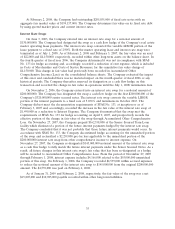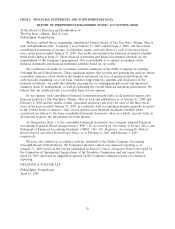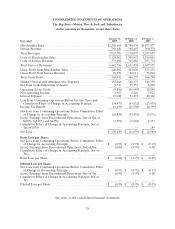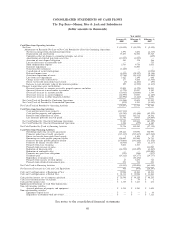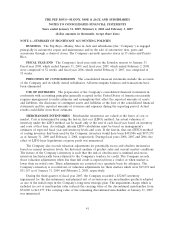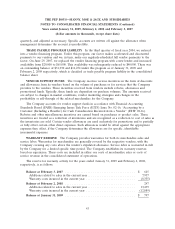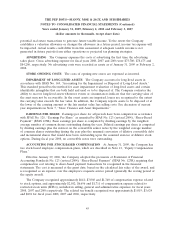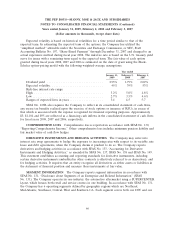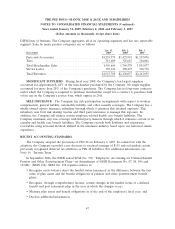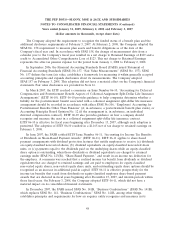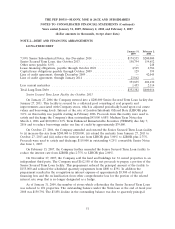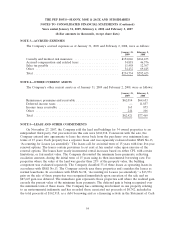Pep Boys 2008 Annual Report Download - page 109
Download and view the complete annual report
Please find page 109 of the 2008 Pep Boys annual report below. You can navigate through the pages in the report by either clicking on the pages listed below, or by using the keyword search tool below to find specific information within the annual report.THE PEP BOYS—MANNY, MOE & JACK AND SUBSIDIARIES
NOTES TO CONSOLIDATED FINANCIAL STATEMENTS (Continued)
Years ended January 31, 2009, February 2, 2008 and February 3, 2007
(dollar amounts in thousands, except share data)
potential real estate transactions to generate future taxable income. To the extent the Company
establishes a valuation allowance or changes the allowance in a future period, income tax expense will
be impacted. Actual results could differ from this assessment if adequate taxable income is not
generated in future periods from either operations or projected tax planning strategies.
ADVERTISING The Company expenses the costs of advertising the first time the advertising
takes place. Gross advertising expense for fiscal years 2008, 2007 and 2006 were $73,700; $78,475 and
$84,206, respectively. No advertising costs were recorded as assets as of January 31, 2009 or February 2,
2008.
STORE OPENING COSTS The costs of opening new stores are expensed as incurred.
IMPAIRMENT OF LONG-LIVED ASSETS The Company accounts for long-lived assets in
accordance with SFAS No. 144, ‘‘Accounting for the Impairment or Disposal of Long-Lived Assets.’’
This standard prescribes the method for asset impairment evaluation of long-lived assets and certain
identifiable intangibles that are both held and used or to be disposed of. The Company evaluates the
ability to recover long-lived assets whenever events or circumstances indicate that the carrying value of
the asset may not be recoverable. In the event assets are impaired, losses are recognized to the extent
the carrying value exceeds the fair value. In addition, the Company reports assets to be disposed of at
the lower of the carrying amount or the fair market value less selling costs. See discussion of current
year impairments in Note 7, ‘‘Store Closures and Asset Impairments.’’
EARNINGS PER SHARE Earnings per share for all periods have been computed in accordance
with SFAS No. 128, ‘‘Earnings Per Share’’ as amended by SFAS No. 123 (revised 2004), ‘‘Share-Based
Payment’’ (SFAS 123R). Basic earnings per share is computed by dividing earnings by the weighted
average number of common shares outstanding during the year. Diluted earnings per share is computed
by dividing earnings plus the interest on the convertible senior notes by the weighted average number
of common shares outstanding during the year plus the assumed conversion of dilutive convertible debt
and incremental shares that would have been outstanding upon the assumed exercise of dilutive stock
options. During fiscal year 2008, no convertible notes were outstanding.
ACCOUNTING FOR STOCK-BASED COMPENSATION At January 31, 2009, the Company has
two stock-based employee compensation plans, which are described in Note 12, ‘‘Equity Compensation
Plans.’’
Effective January 29, 2006, the Company adopted the provisions of Statement of Financial
Accounting Standards No. 123 (revised 2004), ‘‘Share-Based Payment’’ (SFAS No. 123R) requiring that
compensation cost relating to share-based payment transactions be recognized in the financial
statements. The cost is measured at the grant date, based on the calculated fair value of the award, and
is recognized as an expense over the employee’s requisite service period (generally the vesting period of
the equity award).
The Company recognized approximately $641; $3,060 and $1,340 of compensation expense related
to stock options, and approximately $2,102; $6,696 and $1,711 of compensation expense related to
restricted stock units (RSUs), included in selling, general and administrative expenses for fiscal years
2008, 2007 and 2006 respectively. The related tax benefit recognized was approximately $1,019; $3,624
and $894 for fiscal years 2008, 2007 and 2006, respectively.
45


